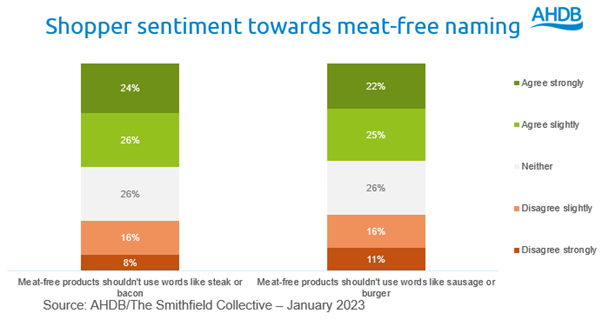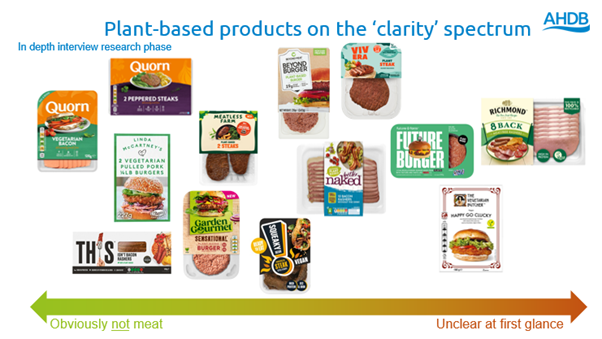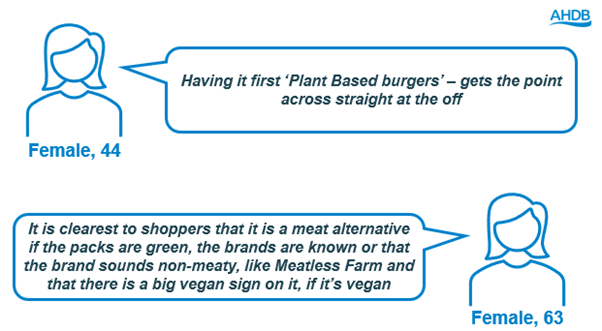- Home
- Some meat-free products could be confusing to shoppers
Some meat-free products could be confusing to shoppers
Clear labelling is important to enable shoppers to choose the right products for them.
Shoppers expressed a level of confusion with meat-free products. There is a clarity spectrum based on how familiar shoppers are with the brand and how explicit the product is about being vegan or vegetarian. There is a level of awareness with consumers that meat-free products are trying replicate meat, with 69% agreeing meat-free products try to describe themselves in a way that sounds like meat. This leads to half of shoppers saying meat-free products shouldn’t use words like steak or bacon.
Research was undertaken by AHDB with The Smithfield Collective to understand shoppers’ behaviour towards meat-free products. This article forms part of the larger research project, full details of which and methodology can be found on the meat-free research landing page.
Association with meat or meat-free products
To understand if language used on meat-free products is misleading to consumers, we used a timed emotional response to see which words were more associated with meat or meat-free.
Due to the words we used and the majority of respondents being meat eaters, the terms were much more associated with meat than meat-free products. The words most associated with meat-free products are burger, sausages and mince. This may be because these are currently the formats which are most likely to have a meat-free product so consumers may be more familiar with these being sold. However, less common cuts to have a meat-free product such as steaks or chops have much less association with meat-free.

Despite over half of shoppers saying they associate the words burger and sausage with meat-free products, many still say they would prefer non-meat products not to use these terms. 47% agree that meat-free products shouldn’t use words like sausage and burger, with this rising to 50% agreeing they shouldn’t use words like steak or bacon.

Shoppers are very used to vegetarian versions of more processed items (sausages, mince, burgers), and words which describe a preparation process that can be done to different ingredients are more likely to be accepted for use on plant-based products.
Nowadays there are more meat-free cuts available to consumers, so there is a widening of categories that has a meat-free offer such as steak. Shoppers are aware of this with 69% agreeing meat-free products are often described in a way that makes them seem like meat. As many people don’t currently associate words which do not have meat-free products such as chops, they currently have an exclusive connection with meat which could be protected.
There is still currently more onus on cuts to announce they are a meat-free product by highlighting it before the product name e.g. plant-based steak or meat-free bacon.
Furthermore, from our interviews with shoppers it was clear that using meat-based descriptions can be helpful for those who wanted to buy a meat-free product that tasted as much as possible like the meat it was to substitute, and so they were able to understand the types of dishes or occasions where the meat-free product would be suitable.
However, older meat eaters were less happy with use of meat terms such as steak or pulled pork to describe what is “not really meat”. ‘T-bone’ raised some eyebrows as it was hard for shoppers to imagine it being so easily achieved by a meat-free product, however, as long as the packaging was clear it was meat-free, most shoppers had no strong aversion to it.
Clarity of meat substitute products
When we showed shoppers the names on packs, it became clearer that some packs were more confusing for shoppers than others. This also came through when we asked shoppers to identify meat-free products on a virtual shelf.
The most confusion came from brands which are more well-known for meat products. Brands are the first thing consumers look for when buying meat-free products. This is shown in the main drivers of buying meat-free products, with 37% of shoppers buying meat-free products because they like the brand.
Therefore, brands which shoppers are more familiar with being meat-free need to be less explicit on the packaging that it is vegetarian of vegan product.

While the language used on products is important to convey plant-based products, the pack itself and the product can also give cues to shoppers that products aren’t meat. Shoppers look at the product itself to decide on the quality. Especially when they are displayed next to each other, it is clear that most plant-based options look a lot less visually appealing compared to meat. However, as meat-free products get better at replicating the look of meat, shoppers can also feel they have been misled.

Meat-free packs using headline product naming words considered to be strongly associated with meat products have the potential to cause misattribution. This is especially true for brands which shoppers associate more with meat products. Those packages which have plant-based or meat free labelling small or in third place behind the brand and the product name can leave consumers feeling confused. While meat-free products have a lot more pressure on the packs than meat and it is more important for these products to communicate their health and environmental credentials, these should not come at the expense of clearly informing shoppers the product is meat-free. Clear signposting for consumers is critical to empower the consumer to make direct choices if they want to buy meat or a meat-free product.

Sign up to receive the latest information from AHDB
While AHDB seeks to ensure that the information contained on this webpage is accurate at the time of publication, no warranty is given in respect of the information and data provided. You are responsible for how you use the information. To the maximum extent permitted by law, AHDB accepts no liability for loss, damage or injury howsoever caused or suffered (including that caused by negligence) directly or indirectly in relation to the information or data provided in this publication.
All intellectual property rights in the information and data on this webpage belong to or are licensed by AHDB. You are authorised to use such information for your internal business purposes only and you must not provide this information to any other third parties, including further publication of the information, or for commercial gain in any way whatsoever without the prior written permission of AHDB for each third party disclosure, publication or commercial arrangement. For more information, please see our Terms of Use and Privacy Notice or contact the Director of Corporate Affairs at info@ahdb.org.uk © Agriculture and Horticulture Development Board. All rights reserved.

